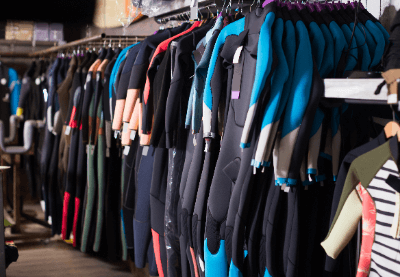All Categories
History



This section provides an overview for dry suits as well as their applications and principles. Also, please take a look at the list of 10 dry suit manufacturers and their company rankings. Here are the top-ranked dry suit companies as of January, 2026: 1.Johnson Outdoors, Inc., 2.Level Six, 3.Hiko USA.
Table of Contents
Categories Related to Dry Suits

A dry suit is a type of attire worn when submerging underwater, such as in the sea or lakes.
Designed with waterproof features to prevent water infiltration into the suit, it serves various purposes. It not only protects against life-threatening conditions in cold underwater environments but is also suitable for tasks in water containing contaminants. Additionally, it prevents a drop in body temperature and comes in various types, including suits with excellent insulation properties and those combined with innerwear.
Dry suits are categorized into two types: the neoprene type, made from synthetic rubber, and the shell type, constructed with waterproof materials like nylon. In Japan, dry suits made of synthetic rubber are commonly used.
Apart from preventing water infiltration, dry suits provide insulation to protect body temperature. These dual functions make them suitable for activities in low water and air temperatures, both underwater and on the water's surface.
For underwater activities, dry suits are worn when the water temperature is approximately below 23°C. They are used in leisure diving, underwater construction work, search and rescue operations during water emergencies, and fishing conducted through diving.
On the water's surface, they are utilized primarily during colder seasons for marine sports such as surfing, windsurfing, jet skiing, and yacht sailing. In situations where individuals involved in rescue operations or fishing are at risk of falling into cold water, dry suits are worn for protection.
Dry suits are one-piece garments, including integrated boots, gloves, and hoods. The loose fit allows for the wearing of dedicated innerwear between the suit and the body. They are donned and doffed through waterproof zipper openings, effectively preventing water penetration, and maintaining a protective seal.
The materials used in dry suits vary between neoprene suits and shell suits.
Neoprene suits use foamed chloroprene fabric, often with jersey or fleece on the inside and jersey on the outside. The outer surface of the foamed chloroprene rubber fabric is radially coated with a rubber-like non-absorbent material.
Materials used in shell suits include compressed neoprene, biaxial laminate, triaxial laminate, vulcanized rubber, and waterproof breathable fabrics. Compressed neoprene fabric with high hardness is used. Biaxial and triaxial laminates involve attaching fibrous fabric to one side of a waterproof film, while vulcanized rubber refers to materials where polyester fabric is coated with elastomer. Waterproof breathable fabrics such as Gore-Tex are also used.
Dry suits are mainly classified into neoprene suits and shell suits.
Most dry suits available in Japan are neoprene suits. Constructed with foamed chloroprene fabric, they have a tight fit and provide insulation even if water enters the interior. However, they are not suitable for use in cold water without thick undergarments, and their insulation cannot be adjusted, making them less suitable for warm water.
Foamed neoprene fabric, containing air bubbles, changes insulation properties with surrounding water pressure and is prone to pinhole formation. While excelling in underwater mobility, they have limited mobility on land.
Shell suits are made with waterproof fabric, offering a loose fit. They lack inherent insulation, relying on innerwear for thermal protection, making them suitable for extreme cold to high water temperature environments. While underwater mobility is limited, they provide excellent mobility on land due to the lack of necessary fabric stretch. They are durable and offer strength without changes in buoyancy or insulation under water pressure, although they are less common in circulation.
*Including some distributors, etc.
Sort by Features
Sort by Area

NRS founded in Moscow, Idaho, USA, in 1972, is a manufacturer of inflatable rafts and other boating supplies for river running. The company’s product portfolio includes bags, inflatable rafts, clothing, paddles, and flotation systems. Its inflatable rescue rafts/boats are used in snow, mud, or turbulent waters to dispatch safe rescues. In 2014, the company became 100% employee-owned. It is a member of the Northern Forest Canoe Trail and American Rivers. Founder Bill Parks started this company with $2,000 from his savings.

Aqualung America Inc., established in 1952 as U.S. Divers Company, is a scuba equipment manufacturer based in Carlsbad, California, United States, operating under Aqualung Group. The company provides various diving and freediving gear, including wetsuits and drysuits, buoyancy control devices, and navigation tools. It also manufactures snorkeling equipment, such as masks, snorkels, and footwear. Notably, the company introduced the scuba diving regulator, incorporating technologies like the auto closure device (ACD), over-balanced mechanism (OBM), and master breathing system (MBS). In addition, the company has developed a mobile app that facilitates the connection of computers to smartphones for dive data management.

Ranking as of January 2026
Derivation Method| Rank | Company | Click Share |
|---|---|---|
| 1 | Johnson Outdoors, Inc. |
23.4%
|
| 2 | Level Six |
12.7%
|
| 3 | Hiko USA |
9.4%
|
| 4 | Diving Unlimited International, Inc. |
9.0%
|
| 5 | Huish Outdoors, LLC |
9.0%
|
| 6 | Extreme Exposure LLC |
8.6%
|
| 7 | Kokatat, Inc. |
8.2%
|
| 8 | Gill North America Inc. |
7.8%
|
| 9 | NRS |
6.6%
|
| 10 | Aqualung America, Inc. |
5.3%
|
Derivation Method
The ranking is calculated based on the click share within the dry suit page as of January 2026. Click share is defined as the total number of clicks for all companies during the period divided by the number of clicks for each company.Number of Employees
Newly Established Company
Company with a History
*Including some distributors, etc.
*Including some distributors, etc.
| Country | Number of Companies | Share (%) |
|---|---|---|
 United States of America
United States of America
|
1 | 100.0% |